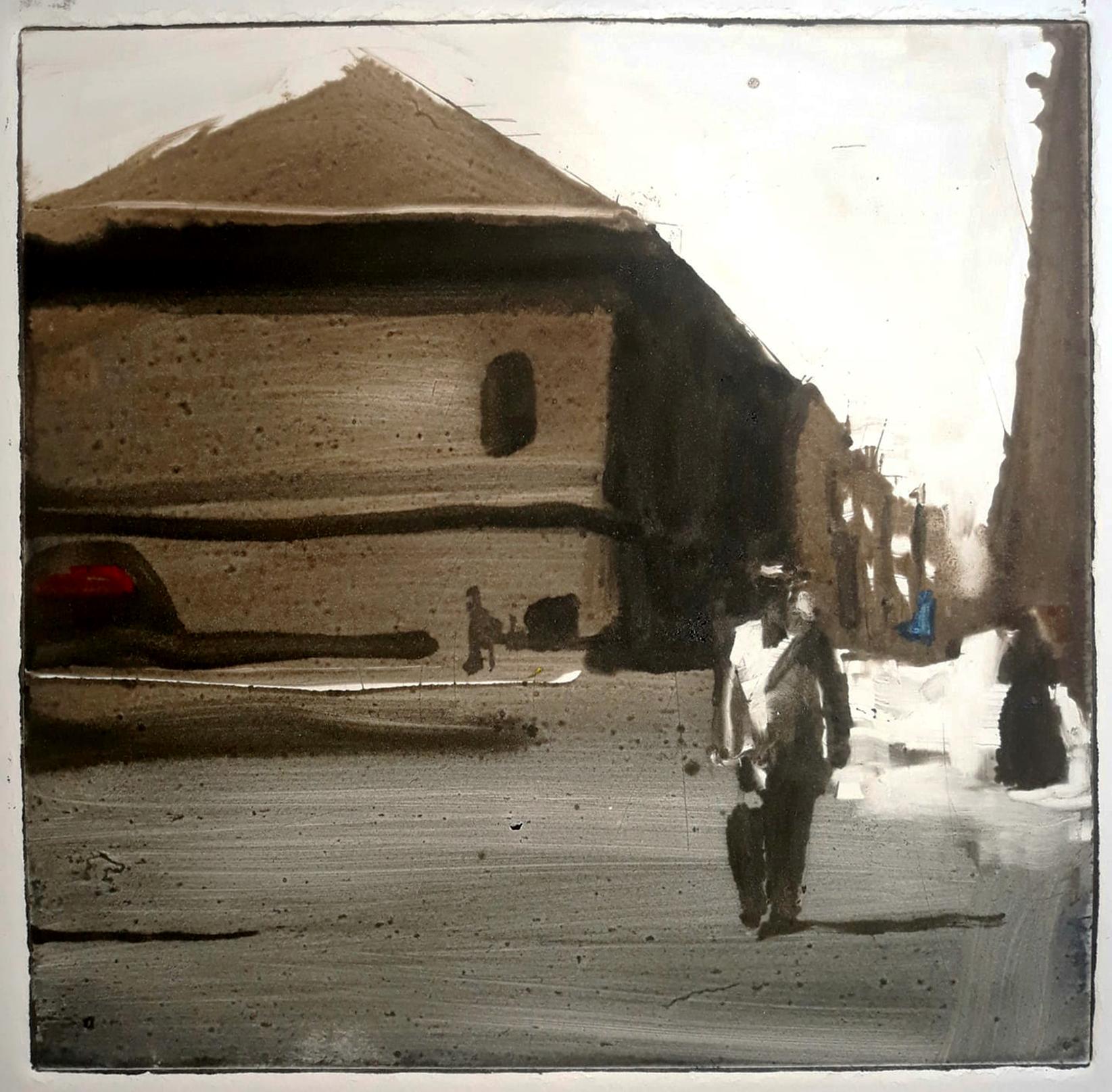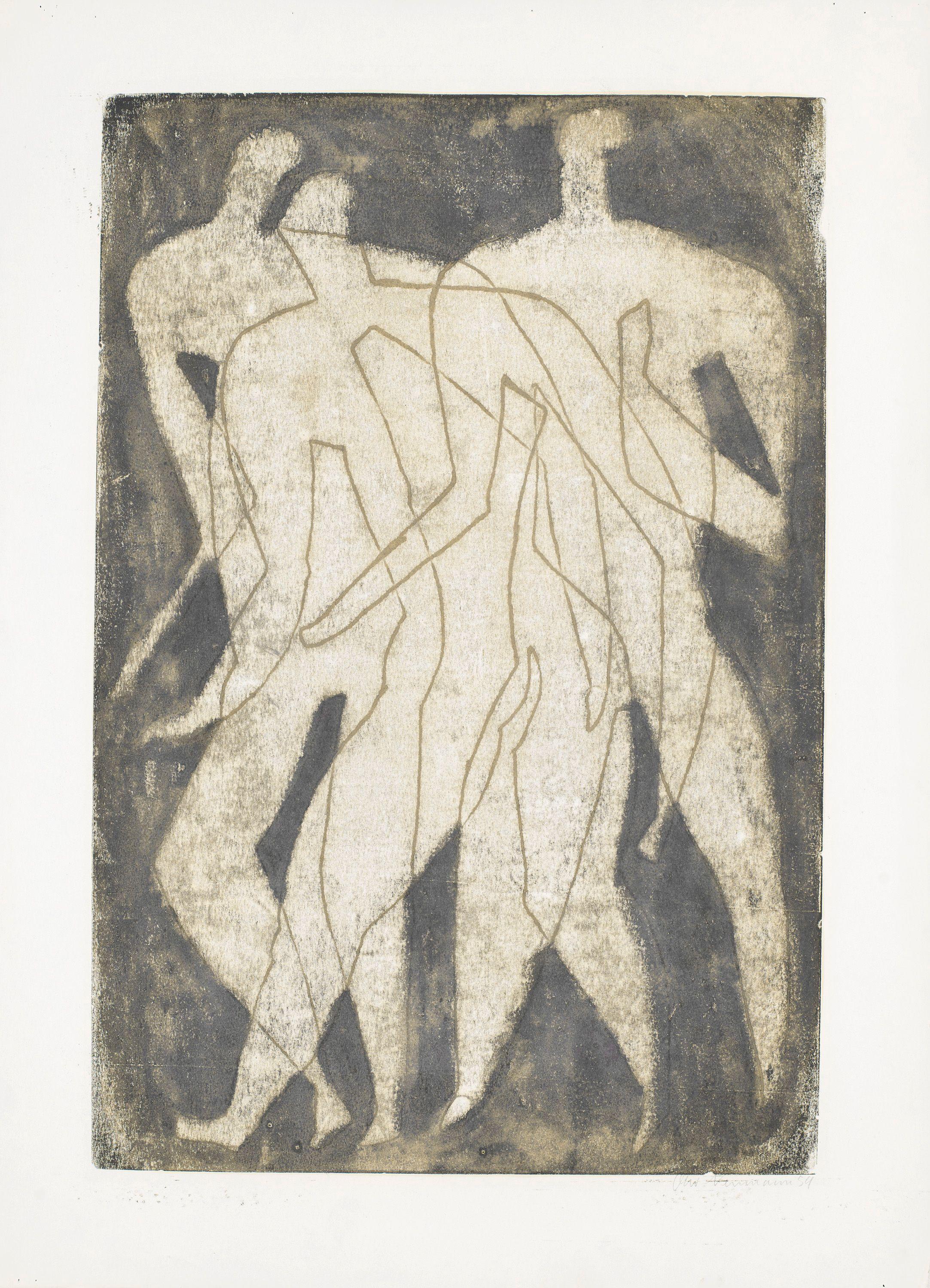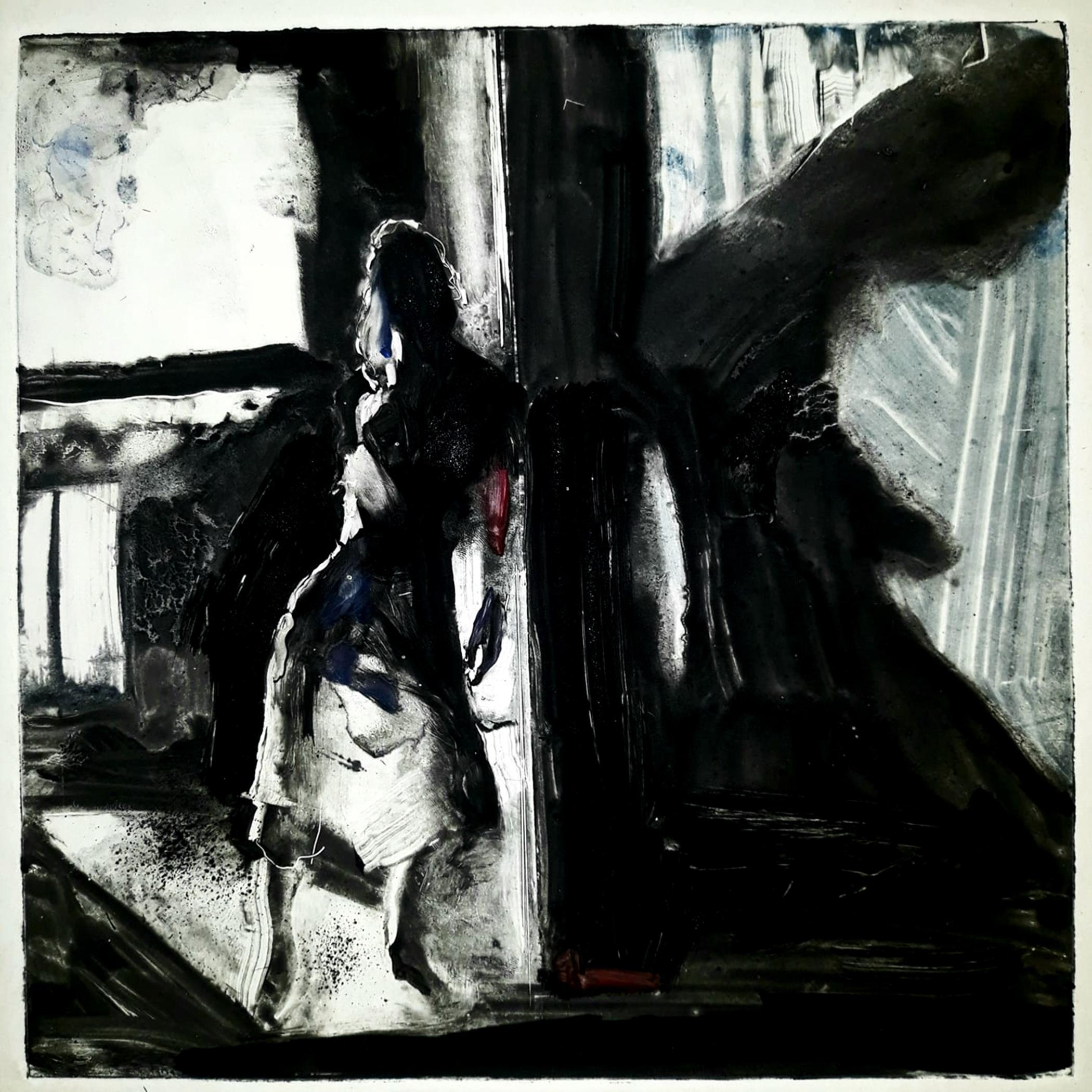Items Similar to Waiting for Buddha, expressionistic female figure, greens, earth tones
Want more images or videos?
Request additional images or videos from the seller
1 of 5
Tom BennettWaiting for Buddha, expressionistic female figure, greens, earth tones2021
2021
About the Item
An oil-based ink monotype of an expressive figure turned from the viewer against a patterned green-grey background.
- Creator:
- Creation Year:2021
- Dimensions:Height: 18 in (45.72 cm)Width: 12 in (30.48 cm)Depth: 0.2 in (5.08 mm)
- Medium:
- Movement & Style:
- Period:
- Condition:
- Gallery Location:Brooklyn, NY
- Reference Number:1stDibs: LU133917834532
About the Seller
5.0
Gold Seller
These expertly vetted sellers are highly rated and consistently exceed customer expectations.
Established in 2005
1stDibs seller since 2020
84 sales on 1stDibs
Typical response time: 2 hours
- ShippingRetrieving quote...Ships From: Wilmington, DE
- Return PolicyA return for this item may be initiated within 7 days of delivery.
More From This SellerView All
- Ghosts of New York 5, mysterious, monochromatic cityscapeBy Tom BennettLocated in Brooklyn, NYOne of a series of oil based monotypes on fine printmaking paper, subtle color design, symbolic and atmospheric figure/figures in cityscapeCategory
2010s Expressionist Landscape Prints
MaterialsMonotype, Archival Paper
- Hyposomnia, solitary mysterious figure, earth tones, nightBy Tom BennettLocated in Brooklyn, NYOil based ink and paint monotype on fine printmaking paper. Expressionist female figure in abstracted landscape, active ink and paint manipulation.Category
2010s Expressionist Figurative Prints
MaterialsMonotype
- Eremitic, monotype powerful black and white, light and shadowBy Tom BennettLocated in Brooklyn, NYA monotype created with oil based etching inks and oil paint printed from a plexiglass matrix. Expressive, Figurative image with stark light and shadow.Category
2010s Expressionist Figurative Prints
MaterialsMonotype
- Brave New World 1, dramatic, black & white Ashcan, AmericanaBy Tom BennettLocated in Brooklyn, NYDramatic imagery from Tom Bennett’s series of black and white monotypes, blending surrealistic mindscapes with stark realism About Tom Bennett: With quick brushstrokes, Tom Bennett ...Category
2010s American Realist Figurative Prints
MaterialsArchival Paper, Monotype
- The Great Depression 3, dramatic, black & white, noir, mystery, genreBy Tom BennettLocated in Brooklyn, NYDramatic imagery from Tom Bennett’s series of black and white monotypes, blending surrealistic mindscapes with stark realism About Tom Bennett: With quick brushstrokes, Tom Bennett ...Category
2010s Surrealist Figurative Prints
MaterialsMonotype, Archival Paper
- Asphalt Jungle, black and white, interior, crime scene, narrativeBy Tom BennettLocated in Brooklyn, NYDramatic imagery from FILM NOIR series of black and white monotypes, blending surreal mindscapes with stark realism About Tom Bennett: With quick brushstrokes, Tom Bennett creates r...Category
2010s Abstract Impressionist Interior Drawings and Watercolors
MaterialsArchival Paper, Monotype
You May Also Like
- 055065By Otto NeumannLocated in New Orleans, LAOtto Neumann (1895-1975) was an expressionist painter and printmaker born in Heidelberg, Germany. He was one of the most versatile and original artists of the twentieth century. Neum...Category
1960s Expressionist Figurative Prints
MaterialsMonotype
- 063062By Otto NeumannLocated in New Orleans, LAOtto Neumann (1895-1975) was an expressionist painter and printmaker born in Heidelberg, Germany. He was one of the most versatile and original artists of the twentieth century. Neum...Category
1960s Expressionist Figurative Prints
MaterialsMonotype
- Blues Melody 2By Kathleen SherinLocated in Buffalo, NYAn original drypoint monotype by American female artist Kathleen Sherin.Category
1990s Expressionist Figurative Prints
MaterialsDrypoint, Monoprint, Monotype
- Blues Melody 3By Kathleen SherinLocated in Buffalo, NYAn original drypoint monotype by American female artist Kathleen Sherin.Category
1990s Expressionist Figurative Prints
MaterialsDrypoint, Monoprint, Monotype
- H.O. Miethke Das Werk folio "The Sisters" collotype printBy Gustav Klimt & K.K. Hof-und StaatsdruckereiLocated in Chicago, ILDAS WERK GUSTAV KLIMTS, a portfolio of 50 prints, ten of which are multicolor collotypes on chine colle paper laid down on hand-made heavy cream wove paper with deckled edges; under each of the 50 prints is a gold signet intaglio printed on the cream paper each of which Klimt designed for the publication as unique and relating to its corresponding image; H.O. Miethke, Editor-Publisher; k.k. Hof-und Staatsdruckerei, Printer; printed in a limited edition of 300 numbered plus several presentation copies; Vienna, 1908-1914. The idea of collaboration in the arts is anything but new; however it has so often been viewed and assessed as somehow devaluing the intrinsic worth of art. It’s as if it was a dirty secret to be hidden away. More so even than the eroticism explored by Klimt, which divided public opinion, the artistic avant-garde began to boldly flaunt artistic collaboration beginning in the 19th century- which gained steam in the first part of the 20th century- to become a driving vehicle of contemporary artistic creation. Viewed in this context, the folios of collotype prints published by H.O. Miethke in Vienna between 1908-1914 known as Das Werk Gustav Klimts, are important art documents worthy of as much consideration for their bold stand they take on established ways of thinking about artistic collaboration as they are for their breathtakingly striking images. 1908 is indeed a watershed moment in the history of art. To coincide with the 60th anniversary of the reign of Emperor Franz Joseph I, Kunstschau opened in Vienna in May of that year. It was there that Klimt delivered the inaugural speech. Speaking about the avant-garde group’s unifying philosophy of Gesamtkunstwerk, or the synthesis of the arts, Klimt shared his belief that the ideal means to bring artists and an audience together was via “work on major art projects.” It was at Kunstschau 1908 that Klimt first exhibited his most iconic painting, The Kiss, as well as The Sunflower, Water Snakes I and II and Danae. It was at Kunstschau 1908 that Das Werk Gustav Klimts was first available for purchase. Thanks to Galerie Miethke’s organization, Kunstschau 1908 was possible. Miethke’s pioneering art house had become Klimt’s exclusive art dealer and main promoter of his modernist vision. Paul Bacher and Carl Moll, a founding member with Klimt of the Vienna Secession, who all broke away during the rift in 1905, took stewardship of the gallery following the fallout with the Secession. Das Werk Gustav Klimts is a prime example of Miethke’s masterful and revolutionary approach to marketing art. Miethke’s innovative marketing strategy played to a penchant for exclusivity. The art gallery and publishing house utilized the press and art critics- such as Austria’s preeminent Art Historian, Hugo Haberfield, who became Director of the gallery in 1912- as a means of gaining publicity as well as maintaining effective public relations. Miethke used the grand exposition format to extend the art gallery’s market reach, cultivating their product’s prestige by stroking the egos of current art patrons while simultaneously creating accessibility for newcomers and others avid collectors to share a relative proximity to other wealthy and respected members of the art collecting community. Essentially, their approach paved the way for what is still the predominant means of marketing. Between 1908 and 1914, H.O. Miethke published a total of 5 installments of print folios of Klimt’s painted work, each comprising 10 prints. The series was limited in availability to 300 and purchase was arranged through subscription. Each issue was presented unbound in a gold embossed black paper folder. Included in the folio was a Title Page, a Justification page and a Table of Contents page itemizing each of the 10 printed works with details about their corresponding painted works as well as information about each work’s current owner. These folios were not comprehensive of Klimt’s work; but rather, they feature what he believed were his most important paintings from 1898-1913. Only 2 collotypes in each folio were multicolored. To punctuate the fact that Klimt, himself, was very much an active player in creating these printed works, he created square-shaped signets, unique to each collotype which were intaglio printed in gold ink at the bottom of the cream wove papers to which the chine collie papers were affixed.These signets relate thematically to their corresponding printed images and designate each of those images by their placement in the folio’s Table...Category
Early 1900s Vienna Secession Figurative Prints
MaterialsArchival Paper
- Max Eisler Eine Nachlese folio “Portrait of Baroness Bachofen-Echt” collotypeBy (after) Gustav KlimtLocated in Chicago, ILAfter Gustav Klimt, Max Eisler #22, Bildnis Baronin Bachofen-Echt; multi-color collotype after 1914-1916 painting in oil on canvas. GUSTAV KLIMT EINE NACHLESE (GUSTAV KLIMT AN AFTERMATH), a portfolio of 30 collotypes prints, 15 are multi-color and 15 are monochrome, on chine colle paper laid down on heavy cream-wove paper with deckled edges; Max Eisler, Editor-Publisher; Osterreichischer Staatsdruckerei (Austrian State Printing Office), Printer; in a limited edition of 500 numbered examples of which: 200 were printed in German, 150 were printed in French and 150 were printed in English; Vienna, 1931. 2018 marks the 100th anniversary of Gustav Klimt’s death. It is a fitting time to reflect upon the enduring legacy and deep impact of his art. Recognizing this need for posterity with uncanny foresight, the publication of Gustav Klimt: An Aftermath (Eine Nachlese) provides a rare collection of work after Klimt which has proven to be an indispensable tool for Klimt scholarship as well as a source for pure visual delight. Approximately 25 percent of the original works featured in the Aftermath portfolio have since been lost. Of those 30, six were destroyed by fire on 8 May 1945. On that fateful final day of WWII, the retreating Feldherrnhalle, a tank division of the German Army, set fire to the Schloss Immendorf which was a 16th century castle in Lower Austria used between 1942-1945 to store objects of art. All three of Klimt’s Faculty Paintings: Philosophy, Medicine and Jurisprudence (1900-1907), originally created for the University of Vienna, were on premises at that time. Also among the inventory of Klimt paintings in storage there was art which had been confiscated by the Nazis. One of the most significant confiscated collections was the Lederer collection which featured many works by Gustav Klimt such as Girlfriends II and Garden Path with Chickens...Category
1930s Vienna Secession Figurative Prints
MaterialsArchival Paper
Recently Viewed
View AllMore Ways To Browse
Green Grey
Green Buddha
Bennett Tom
Green Rose Picture
The Magic Flute
Figural Sculpture Christian
Calder Exhibition Poster
Antique Pencil Portrait
Keith Haring Tony Shafrazi
Picasso Poster Cubism
Vintage Heart Key
Built In Wall System
Grant Wood Lithographs
Chagall Original Etching
Hares Antiques
Dancing Couple Sculpture
Ink Sketch Woman
The Problem We All Live With




